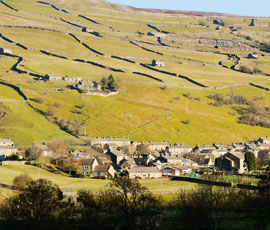Challenging market for many small farms

Despite the boom in farmland market values, many smaller properties with a run-down residential element are proving hard to sell in some areas. Robert Harris reports
Over the past few years the land market has flourished and has now reached record highs.
The North East is no exception – well-serviced working farms with a reasonable house are selling well across the region, says David Coulson, partner at Co Durham-based Addisons Chartered Surveyors.
However, one sector has become much more fickle. Traditional small farms have become harder to sell, especially where the house and buildings are in poor condition and particularly those in the northern dales that offer little in the way of tourist potential.
“At the peak of the property market in August 2007 investors were prepared to pay good money for older properties and renovate them but these purchasers are now finding it harder to borrow money,” says Mr Coulson.
“Additionally, as a result of the economic downturn there are many more bargains at auctions when repossessed homes are often sold below market value, and require only limited work. Investors can spend less money and get excellent rates of return.”
As a result, farmers are now the main target for vendors of small farms. However, most just want the land and those that do require a house and buildings, perhaps as a starter unit for offspring, want them ready to go, says Mr Coulson.
“A farmer can move straight on to a fully serviced farm and run the business smoothly,” he says. “However, renovating a house can take a long time. Additionally, the timing of new buildings construction is vital – for example, livestock farmers will want to avoid internal housing periods, lambing and silage/haymaking time.”
To maintain maximum marketability, continued investment in farms is key, something non-farming landlords do not always consider, Mr Coulson advises.
Where buildings are already run down, the best move is to make the house weatherproof and lot the property in the hope of finding a residential buyer, letting the land on an FBT and selling it once the house has sold, he says. “This at least ensures ongoing income and opens up the sale to another market.”
For those who need to cash in, the best option is to ask a realistic price that reflects the amount of work required, Mr Coulson adds. “I would not advise spending money on property improvements as that will make little difference to an agricultural audience.”
Eifion Bibby of Shropshire and north Wales-based auctioneers Davis Meade also advises vendors to be realistic.
“The valuation needs to reflect what’s there. Many farmers remain keen to buy smaller units at the right price, and run-down buildings need not be a disadvantage – some buyers will regard them as the opposite, as they are not committed to upgrading them or preserving their value, but they retain a footprint that could be used for future development.”
He too advises vendors not to spend money upgrading the house. “Reduce the price by the amount you would have spent – you are ultimately in the same position.
“Concentrate on technical rather then cosmetic aspects – on really run-down houses that have not been lived in for years, we’d advise vendors to confirm its continued planning status as a residence to ensure it has the correct status to allow future development.”
Maintaining farm buildings is usually money well spent, Mr Bibby adds. “Having useful buildings that are fit for purpose will help. And if there is any chance that old buildings can be developed, preserve them at all costs.”
Although the market has slowed on smaller units, typically up to 50 acres, an older house and buildings needing work can appeal to non-farming buyers looking to put their own stamp on a property, provided condition is reflected in the price, says Richard Webber, a partner with Greenslade Taylor Hunt based in South Molton, Devon.
Farmers are now driving the market for larger farms, he adds. “Most are quite happy with a modest house in which they can make do or let it out. And most farms come with reasonable buildings these days – even if they don’t, many farmers want to incorporate their acquisition into existing enterprises, so may not need the buildings at all.
“The main problem comes when a farm has a large number of listed buildings that have to be maintained. That can be costly.”
Marketing tips
- Traditional small farms can be challenging, especially if house or buildings are in poor condition and there is little alternative income potential
- To maintain maximum marketability, continued investment in farms is key, advise agents
- Weatherproof run-down buildings
- Consider lotting to seek out residential buyers – let land on an FBT and sell land once the house sells
- Price realistically and resist spending on improvements that will make little difference to agricultural audience
- Run-down buildings need not be a disadvantage if not listed – they retain a footprint for potential development
- Confirm planning status as residence for very run-down houses
- Maintaining farm buildings is usually money well spent
- If there is development potential on buildings, preserve them
